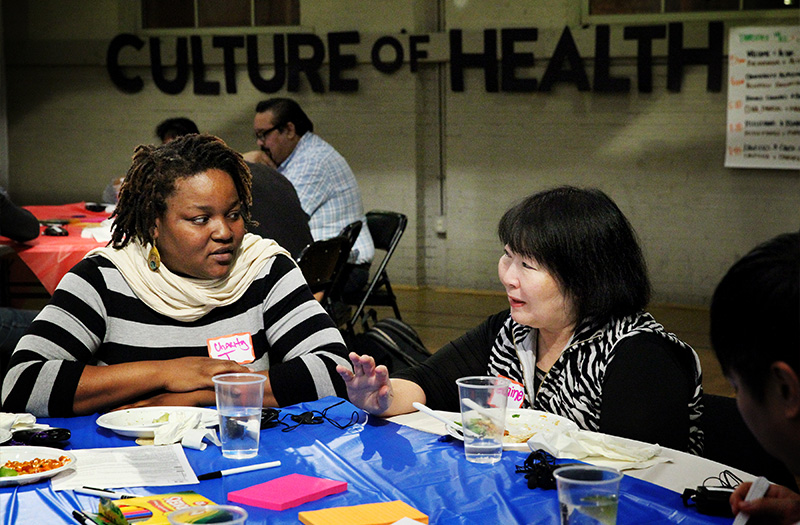
CCHE Phase 1
Seeking innovative strategies to the childhood obesity health epidemic, The Praxis Project and the Robert Wood Johnson Foundation (RWJF) launched, Communities Creating Healthy Environments (CCHE) Phase 1, a national initiative designed to address structural inequalities and environmental risk factors causing food and recreational disparities in low-income communities of color. This focus on root causes required a different type of public health strategy; one in which community-based organizations would implement local policy advocacy projects to advance environmental change using the art and science of community organizing.
The Praxis Project served as the national program office for CCHE. Praxis is a national, nonprofit organization that builds partnerships with local groups to influence policymaking to address the underlying, systemic causes of community problems. Under CCHE, 22 diverse, community-based organizations and tribal groups were supported in the development and implementation of culturally competent community engagement and policy initiatives to address childhood obesity at the local level. Two grantee cohorts, ten in 2009-2012 and twelve in 2010-2013 were selected from nearly 600 applications to implement three-year CCHE projects.
The CCHE national evaluation conceptually incorporated the diversity of social justice lenses found across the grantees as well as the potential influence of culture, place, and organizing approach within each site. The community-based participatory research (CBPR) evaluation of the CCHE initiative employed a complex, mixed methods approach that integrated quantitative (i.e., numerical) and qualitative (i.e., unstructured descriptive) data collected from various sources. Conducting such a comprehensive evaluation required measuring not just the major benchmarks and outcomes of success of the various grantees, but also the discrete processes and procedures that led to these successes. The PARC@LMU team consisted of 7 senior research associates (SRAs) who were matched to 22 grantees based on their research expertise, interests, and where possible, cultural background. The SRAs used a CBPR approach to create positive partnerships between the individual SRAs and their assigned grantees; these partnerships endured throughout the CCHE initiative and allowed the SRAs to collect sensitive data and honest observations and opinions from the key informants: CCHE initiative administrators, grantee staff including directors, community organizers, outreach workers, and in some cases residents within the target communities. Over the course of the CCHE initiative, 21 grantees achieved 367 accomplishments across three major domains of the CCHE Change Model: (1) Organizational Capacity (n = 31), (2) Organizing Strategies (n = 156), and (3) Policy Campaigns (n = 180), and set the stage for grantee policy wins. Grantees won 75 policy wins with each grantee winning an average of 3.43 wins. The largest number of wins (n = 27) were achieved in the area of improving healthy, affordable food access to community residents, in particular children. The second largest number of wins (n = 24) involved increasing children’s access to safe, recreational activities and spaces for play and physical activity. Other areas that grantees achieved policy wins were: (1) improving healthcare access for community children (n = 7), (2) increasing environmental protections to make the environment healthier for children (n = 6), (3) promoting housing/shelter access for children (n = 6), and increasing student and resident welfare in the community (n = 2).

CCHE Phase 2
Although CCHE Phase 2 continued to use a community organizing approach with a consistent, critical race lens in addressing childhood obesity, the focus shifted to supporting and developing a policy advocacy network—i.e., the Transformative Schools Network (TSN)— capable of launching national policy campaigns in RWJF priority issue areas. The CCHE strategy was to leverage existing networks (Alliance for Educational Justice-AEJ, Communities Justice Network for Youth-CJNY, and former CCHE grantees) to build capacity and connections among key organizing communities and networks that could influence policy decisions and transform systems.
PARC employed a mixed-methods evaluation design that included a social network analysis questionnaire used at the beginning of the project to: a) provide baseline information to assist with identifying the core network of groups that make up the TSN, b) gather background information to understand specific policy and organizing expertise and capacity needs of the TSN, c) visually map the network, c) assist Praxis and other partners with further developing and leveraging the network, and d) designing and implementing technical assistance supports for network members. Qualitative interviews with The Praxis Project staff and TA Partners including a review of TSN documents and records was also conducted to capture accomplishments in the following areas: a) purpose, goals, strategies and tactics of the national campaign; b) growth of and connectivity within the TSN including new collaborations; c) technical support and resources provided the TSN; and d) the extent to which they advanced the CCHE priority policy targets with social justice organizations and the broader public.